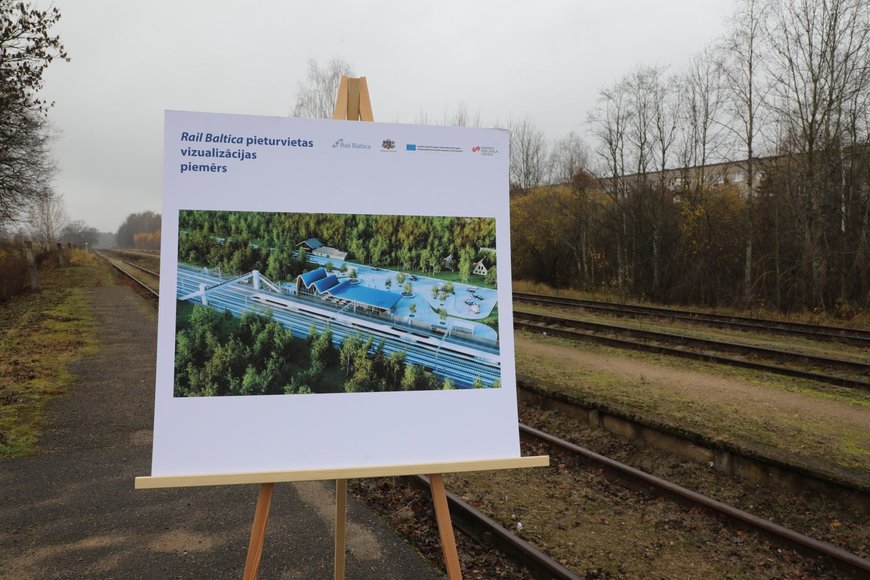railway-international.com
08
'22
Written on Modified on
Rail Baltica high-speed infrastructure in Latvia will include 16 regional mobility points; construction design agreement was signed today
In addition to the international passenger stations in Riga – Riga Central Station and Rail Baltica station at the Riga International Airport, both of which are already in the construction, 16 regional mobility points are planned on Rail Baltica mainline in Latvia.

On 4 November, construction designing was marked by signing the cooperation agreement between the contracting authority Rail Baltica national implementing body in Latvia “Eiropas Dzelzceļa līnijas” and the winner of the public competition – association of persons “RERE INECO”.
The experience Latvian-Spanish association of companies will develop the construction designs by 2024 and will conduct author’s supervision until commissioning of the buildings.
“Rail Baltica will significantly change the regional mobility and expand the opportunity of choice of mobility – the speed and precision ensured by train traffic will enable diverting the passenger flow from private to public transport. To implement this, cooperation among all the parties involved and the local government plays crucial role for full use of the potential offered by the Rail Baltica stations in the future”, says Mr Tālis Linkaits, Minister for Transport of the Republic of Latvia.
Regional trains of Rail Baltica line will stop both at international stations and regional stops and reach the speed of up to 200 km/h. Within the framework of designing, 16 mobility points are planned on the Rail Baltica mainline in Latvia.
“With introduction of Rail Baltica, an overturn in mobility habits is expected. As soon as the Rail Baltica regional trains will start running, people will no longer have to adjust by choosing their places of residence at a closer distance from the centre or Riga or their own vicinities – for example, vicinity near Bauska or Salacgrīva will be equally good location the place of residence, and the place of work will be reachable quickly and conveniently. Furthermore, opportunities to create new jobs in regions or even work in the neighboring countries, for example, in Kaunas or Parnu, will be provided”, stressed Mr Kaspars Vingris, Chairman of the Board of Eiropas Dzelzceļa līnijas. “In order to create symbiosis between the regional mobility, micro mobility and railway, close cooperation of local governments aimed at adjustments of the vicinities will be required, but this will stimulate the regional development and new activities of national economy.”
Jose Maria Llorente representing the construction design procurement winner company association and the Spanish company “Ineco” with its worldwide experience in the design of transport infrastructure, noted that “the company is already actively involved working with Rail Baltica project and is ready to further contribute with its international knowledge to develop the regional station construction design.”
Whereas Mārīte Straume, Chairperson of the board at RERE GRUPA emphasized that “the development of railway lines has historically given additional push to the economic development of new innovations, industries, and countries. Rail Baltica is no exception either.” She also added that “RERE Group” in partnership with the construction company “BERERIX” is already working on Rail Baltica Riga Central Station construction together with colleagues from Belgium and Italy, central station node project together with colleagues from Belgium and Italy. “By combining global and local experience in the right synergy, together with the Rail Baltica project delivery organizations, we will be able to assign specific volumes and shapes to the points currently marked on the map,” she added.
Regional mobility points are expected to bring together different modes of transport – railway, state and municipal buses, private vehicles and electric vehicles, scooters, bicycles and all other micro mobility tools, as well as develop a range of various services.
“Rail Baltica is a cross-border high-speed railway project with the aim to connect the Baltic States both with each other as well as with the wider European railway network. Regional traffic and mobility points will become an essential part of Rail Baltica. However, they will only be as effective as the connections to them with the relevant supporting infrastructure and micro-mobility solutions. Therefore, cooperation with municipalities and local entrepreneurs will remain an important factor in the future, including to plan additional human resources and funding, and to jointly realize the potential that the construction of these stations can bring to the overall development of the municipality,” said Kitija Gruškevica, Head of Latvian branch at RB Rail AS.
While joint architectural, landscaping, and visual design guidelines have been introduced ensure consistent approach across the project, during the design process it will not only be possible, but recommended to incorporate each municipality’s identity, thus ensuring that the mobility point becomes one of the symbols of the municipality,” added Gruškevica.
Rail Baltica railway system is planned in such a way as to be able to provide cross-border traffic of regional trains, thus allowing connection of border regions in Latvia, Lithuania and Estonia. Likewise, the system will enable ensuring efficient transfer to international trains.
Subject to the expected amounts of passengers, overall, three types of regional stations are planned – large, medium, and small stations. Station designs refer to the traditional vertical constructions of buildings in the Baltic States, inspired by the Baltic Sea, whereas station buildings are characterized by a glass facade, enabling designing of the premises light and transparent, as well as using wooden panel decoration for the wall design. Various new technologies are also planned to be used in the stations, and it is planned that all station buildings will be near-zero emission buildings with the highest environmental requirements. When planning regional stations, development of the station’s surrounding area is considered to provide passengers an opportunity to not only enjoy attractive environment, but also use functionally planned, easy-to-use and well-equipped outdoor space.
www.railbaltica.org

